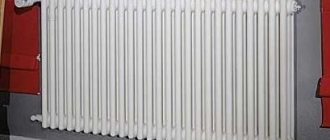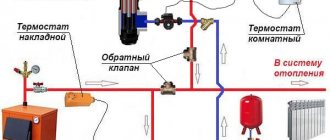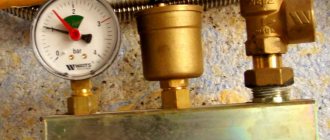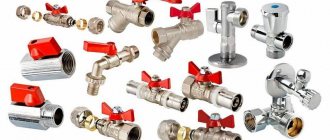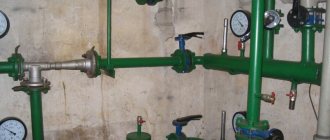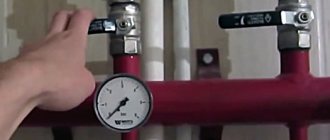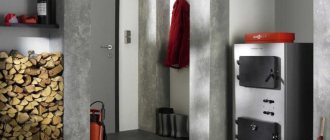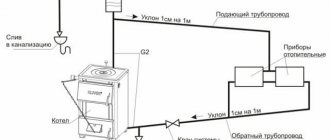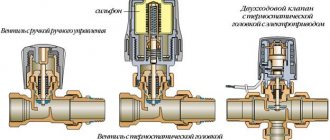Pressure drop during heating correct functioning of the system
Often, the normal functioning of the hydraulic water supply system, plumbing equipment, devices and components, comfortable bathing and other hygiene procedures depend on optimal pressure. Most people believe that the system works by simply supplying liquid, you just have to open the tap. In reality, this system represents a rather complex communications system with its own technical parameters and characteristics. For example, voltage drops during heating are a very common occurrence, sometimes pipes even explode.
Application area
Modern differential pressure regulators are most often used in water heating systems with hydraulic mode. The presence of such a device allows you to achieve the most stable pressure in the pipes involved in the operation of the heating network. If the device is installed correctly, the heating equipment will be reliably protected from zero flow associated with a system restart.
Danfoss ASV-PV, DN15.
Automatic regulators require virtually no maintenance. With relatively simple manipulations associated with setting up devices, they are able to maintain the specified parameters with fairly high accuracy.
The influence of water pressure on system operation
When purchasing the appropriate plumbing equipment or household appliances connected to the water supply system, you need to familiarize yourself with their technical characteristics in advance. One of the parameters is the optimal pressure level at which the devices will operate normally and no drop will be observed.
If a difference occurs in the heating, then problems with heating the room begin. This indicator for washing machines and dishwashers is considered to be a pressure of 2 atmospheres. However, for automatic bathtubs and watering equipment for a vegetable garden or garden, this value is already 4 atmospheres.
The minimum water pressure for autonomous water supply networks in private homes should be at least 1.5 - 2 atmospheres. It is necessary to take into account that several water consumption objects can be connected to the water supply source at the same time.
Also, creating the necessary water pressure is especially important for private homeowners in case of a fire hazard.
Main settings
- Inlet diameter. Ideally, it should match the size of the water pipes;
- The maximum maximum pressure at which operation of the device is guaranteed for a long time without breakdowns;
- Throughput (measured in cubic meters per hour);
- Pressure range that can be adjusted;
- Operating temperature range, which determines the ability of the device to operate in high and low temperature conditions
What pressure value is considered normal?
A stable amount of atmospheres in the main helps to reduce the level of heat loss and ensure that the circulating coolant has almost the same temperature to which it was heated by the boiler.
It is necessary to talk about what the pressure should be, taking into account what kind of heating system we are talking about. Options:
Pressure in the heating system of a private house. With the open heating method, the expansion tank is the communicating link between the system and the atmosphere. Even with the participation of a circulation pump, the number of atmospheres in the tank will be equal to atmospheric pressure, and the pressure gauge will show 0 Bar.
Pressure in the system of a multi-storey building. A characteristic feature of heating systems in multi-storey buildings is high static pressure. The higher the height of the house, the greater the number of atmospheres: in a 9-story building - 5-7 Atm, in 12-story buildings and higher - 7-10 Atm, while the pressure in the supply line is 12 Atm. Therefore, it is necessary to have powerful pumps with a dry rotor.
Heating scheme for a multi-storey building
Pressure in a closed heating system. The situation with a closed highway is somewhat more complicated. In this case, the static component is artificially increased to increase the efficiency of the equipment, as well as to prevent air penetration. The required pressure in the heating system of a private house is calculated by multiplying by 0.1 the difference between the highest and lowest points in meters. This is an indicator of static pressure. By adding 1.5 Bar to it, we get the required value.
Thus, the pressure in the heating system in a private house when installing a closed circuit should be within 1.5-2 atmospheres. An indicator outside the range is considered critical, and when mark 3 is reached, there is a high probability of an accident (depressurization of the main line, failure of units).
Yes, high pressure can improve the operation of the equipment, but the technical characteristics of the installed boiler should be taken into account. Some models can withstand 3 Bar, but most are designed for 2, and in some cases 1.6 Bar
It is important, when setting up the equipment, to achieve a reading in a cold system that is 0.5 Bar lower than the value stated in the passport. This will prevent the pressure relief valve from constantly tripping.
It is important to remember that measuring the water pressure in the heating system or trying to regulate it in a single apartment is pointless. The only thing that depends on the owners of the living space is the choice of batteries and the diameter of the pipes in the pipeline
For example, cast iron is not recommended, as they can only withstand 6 bar. And the use of pipes of larger diameter will lead to a decrease in pressure in the entire heating system of the house. When moving into an apartment with old heating, it is better to immediately replace all possible elements.
Another parameter that affects the amount of pressure in any heating line is the coolant temperature. A certain amount of cold water is pumped into the mounted and closed circuit, which ensures minimum pressure. After heating, the substance will expand and the number of atmospheres will increase. Therefore, by adjusting the water heating temperature, you can control the pressure in the circuit. Today, companies involved in heating equipment offer the use of equipment with hydraulic accumulators (expansion tank). They prevent the pressure from increasing, accumulating energy within themselves. As a rule, they come into operation when the level of 2 atmospheres is reached.
Temperature and pressure distribution in an apartment building
It is important to regularly check the accumulator in order to empty it on time. It would also be useful to install a safety valve, which can be activated at a pressure of 3 atm and a full tank to avoid an accident
Setting the pressure level
After installing the device, it is adjusted to set the required pressure. This procedure is carried out with zero water consumption. Therefore, it is necessary to close the inlet valve and open the outlet valve. There is an adjusting screw on the gearbox. The device is equipped with a special key with which adjustment is carried out. To increase the pressure in the water supply system, turn the screw with a wrench in a clockwise direction. Then you need to slowly unscrew the adjusting screw in the opposite direction until the pressure reaches 3 atmospheres.
The device is installed immediately after the water flow meter, if available. If there is no water meter, the unit is installed before the first branch of the water supply system. If there is no coarse filter at the water supply inlet, then it must be installed in front of the gearbox.
The reducer is an automated device for the water supply network. There are no specific requirements for its maintenance and care. You need to configure it once after installation. During further operation, you can independently adjust the pressure once every six months if necessary. Depending on the quality of the incoming water, the device will need to be removed once a year or 2 years and cleaned with water pipe cleaners that dissolve salt accumulations. You can also add oil to the hole under the adjustment bolt to ensure efficient operation of the valve. When choosing a device that stabilizes water pressure in a water supply system, preference should be given to well-known manufacturers. It is desirable that its design include a pressure gauge.
Source
Features of open and closed heating systems
According to the design of the heating system in private houses, there can be:
- open - it is assumed that there is an expansion tank and a natural type of circulation of the coolant: when heated, it rises up, and as it cools down, it goes down;
- closed - the heating circuit is isolated from the external environment, and the coolant moves thanks to the circulation pump.
For the successful operation of open-type heating, it is necessary that the boiler be located at the lowest point, and the expansion tank at the highest. In this case, the cross-section of the pipes leaving the boiler must be larger than those entering on the return circuit. This system is used mainly in small one-story houses.
Closed type heating is much more common. In this case, the working pressure in the heating of a private closed house should be at the level of one and a half to two atmospheres, provided that the building is small and there are few batteries. If a private house has many rooms or has several floors, an additional circulation pump will be needed.
If the heating system is filled with water for the first time, air may enter the circuit. Once it is removed, the pressure in the system will drop slightly. It will need to be raised a little more, without, however, bringing it to the working value. As the water warms up, the pressure will increase.
Having a pump in a closed system makes it more efficient and economical. Depending on the power of the pump, the heating can be equipped with the required number of batteries and a pipeline of the required length. Radiators are connected in series or parallel (less load on the boiler).
In the off-season, a closed system with a pump allows you to regulate the degree of heating by setting minimum values.
Types of control valves and their parameters
Varieties of special shut-off valves for controlling the heat supply to the radiator include:
- regulators made in the form of valve mechanisms with thermal heads that set a fixed temperature;
- ball valves;
- special balancing valves, manually controlled and installed in private houses - with their help it is possible to evenly heat the interior spaces;
- bleeding air valves - Mayevsky’s manual mechanisms and more advanced automatic air vents.
Ball With thermal head Mayevsky valve Balancing
List is supplemented with samples of valve regulators used for washing batteries and draining water. This class also includes a check valve that prevents the movement of coolant in the opposite direction in networks with forced circulation.
Indicators characterizing the operation of any type of shut-off valves include:
- standard sizes of devices, according to which they are selected for specific types of radiators;
- pressure maintained in operating conditions;
- media temperature limit;
- product throughput.
To correctly select a shut-off valve, you will need to take into account all the parameters together.
Types of heating systems
Based on the type of coolant circulation, heating systems are divided into open and closed. In the first case, the flow of water is due to natural causes. The hot coolant located in the tank is forced out into the main line when cold liquid enters the same container - this occurs due to the difference in density. In addition, there are some nuances that facilitate the flow of water. For example, the lines leading to heating radiators are located at a slight slope, which makes it possible to also use gravitational force in the movement of the coolant.
A closed heating system ensures the movement of water through pipes using special equipment - a circulation pump. This approach has both advantages and disadvantages. For example, the disadvantage is that such a system requires an uninterrupted supply of electricity to operate. but the issue of a possible power outage is easily resolved with the help of a backup power generator.
An advantage of a closed system is a higher dynamic pressure and, accordingly, a higher coolant flow rate. Thus, it manages to pass along the entire circuit without cooling down. Therefore, all radiators in the room heat up evenly.
But an open system cannot boast of this - the slower coolant flow leads to the fact that the radiators furthest from the boiler warm up much worse than the closest ones. Therefore, the number of batteries that can be placed on one circuit with natural circulation is quite limited.
Types of gearboxes
Piston gearboxes
In them, the main work is done by a built-in spring-loaded piston. Using a special tap, you can adjust the control spring. The piston, in turn, will partially block the pipeline when the pressure rises to a critical level.
pros
- These devices are more common and accessible.
- The design is simple, compact and - subject to proper operation - highly reliable.
Minuses
- They have a smaller adjustment range (1–4.5 bar), which, however, is usually enough for domestic use.
- To prevent the device from malfunctioning, the water in the apartment must undergo pre-filtration. Otherwise, small particles will interfere with the operation of the water pressure reducer. As a result, the piston may jam. If you are not ready to purchase additional equipment, you can find good water pressure reducers with a built-in filter.
You may find it useful
Diaphragm reducers
In these reducers, a membrane that is connected to a spring reacts to pressure surges. The spring compresses or expands, causing the valve to restrict the movement of water.
pros
- The sealed chamber protects the mechanism from contamination. This device does not require installation of filters or maintenance.
- Has a large adjustment range (0.5–7 bar).
Minuses
- A diaphragm water pressure reducer can cost twice as much as a piston one.
Heating pressure adjustment
In apartment buildings, the main problem associated with the functioning of the water supply system is low water pressure
This is especially important for tenants on upper floors and private homeowners. When the water supply is weak, household appliances do not work well - washing machines, dishwashers, bathtubs with built-in automation, sprinklers
Increase the voltage drop in the heating:
- installation and installation of pumping equipment that increases the intensity of the incoming water flow;
- equipment of a special pumping station, installation of a storage tank.
The choice of a method for increasing water tension is carried out taking into account the needs for a certain daily volume of supplied water by its consumer and the persons living with him.
Pumping equipment to increase the pressure of water supply to the apartment is inserted into the cold water supply system, after which it is adjusted.
To increase the water voltage in individual nodes of the autonomous water supply system, additional pumps can be installed at the disassembly points.
Features of using autonomous water supply systems
The specific features of the functioning of an autonomous water intake system include the need to collect and supply water from depths from a well or well, as well as ensuring normal water supply to all points and nodes of the water supply system, even in remote places.
When choosing a pump for autonomous water intake, it is necessary to take into account its performance, as well as the performance of the well itself. If the well productivity is low, the water pressure will naturally be insufficient to satisfy the domestic and economic needs of a private homeowner, and if it is large, it will lead to damage to equipment and household appliances, as well as the occurrence of leaks.
The installation of an autonomous pumping station requires the presence of a storage tank, which, together with a hydraulic accumulator, ensures the normal need for water at low system pressure or when it is completely absent from the water supply system.
In heating, pressure adjustment to the optimal level is carried out by turning special screws - regulators located under the pressure switch cover so that a voltage drop does not occur.
It should be remembered that the pumping station requires appropriate maintenance; it is necessary to regularly check the operation of the pump and other hydraulic elements and components, and clean the storage tank. When installing such equipment, it is necessary to take care in advance of sufficient space for its placement, ease of maintenance and repair. The large hydraulic accumulator itself can be buried in the ground, having previously made the necessary waterproofing, and installed in the basement or attic of a country house.
Design and principle of operation of the water pressure regulator (reducer)
In modern conditions, a water supply pressure regulator (WPR) is installed either when laying a home water supply system, if it is a private or apartment building under construction. Or during repairs, which include laying a new water supply system.
The work of the RDV comes down to ensuring that water always flows from the user’s tap with the same pressure. While ensuring an even flow of water, without causing discomfort when taking a shower.
Pressure regulators are made from different types of metal, and are divided into types, which will be described below.
Water pressure reducer
The principle of operation of the reducer boils down to the following - taking on random pressure from the plumbing system. Due to a mechanical pressure sensor installed inside and an adjusting screw that limits the water supply. The outlet pressure regulator provides the pressure gauge reading set by the user.
In addition to the usual pressure gauge, the RDV can be equipped with coarse and fine filters. This will increase the durability of the device. And also install an air blast valve and an additional ball valve to stop the water supply.
Causes of pressure drop
If you find that there is low pressure in your gas boiler, there may be two reasons:
- The heat exchanger has failed.
- There are leaks in the heating circuit.
Any problems with the heating boiler must be identified and corrected as quickly as possible. A drop in pressure can be caused by a manufacturing defect, defects in the expansion tank, clogged heat exchanger, cracks or excessive wear. In any case, all problems should be corrected.
No less often, the pressure in the system drops due to leaks. In particular, they can occur in places of poor-quality soldering of plastic or steel pipes, at joints with radiators, in sections with great wear of the pipe, as well as in the presence of cracks in the rubber gasket in the expansion tank, which leads to coolant entering the air chamber.
You can establish a leak in the rubber membrane by pressing on the spool through which air enters the chamber. If water drips from it, the cause of the pressure drop has been found.
It is somewhat more difficult to detect leaks in pipelines if they run through a wall or under the floor. First of all, they diagnose visible sections of the contour and inspect the condition of the floor to detect stains from dried water. Salt deposits and signs of rust at the joints may also indicate depressurization of the system.
Some systems have the ability to turn off individual sections of the circuit one by one to make it easier to identify leaks.
If visual diagnostics of the condition of a closed pipeline does not produce results, perform pressure testing. This is done by professionals with experience and equipment. First, the coolant must be drained from the circuit, after which the batteries and the boiler are isolated. Then air is pumped into the circuit, bringing the pressure in the system to a value 20% higher than the working one. After a few hours, the pressure level is rechecked. If it falls, they begin to search for a leak. At the same time, on visible sections of the pipeline, the joints are lubricated with a soap solution. Where the soap begins to bubble and hiss, the seal of the circuit is broken.
Next, the defective seam is either sealed or the pipe section is replaced.
Types of regulators
Devices for regulating pressure are divided into several types. Each of them should be considered in more detail.
Piston
This species is most popular among consumers of water resources. Widespread use is largely due to its relatively low cost. It operates due to a piston, which increases or decreases the cross-section of the pipe accordingly. The required flow level can be set using a rotating valve. The output range varies from 1 to 5 atmospheres.
Among the disadvantages of this type of unit, it is worth noting the increased sensitivity of the piston system to the ingress of polluting particles, which leads to breakdowns.
Membrane
When figuring out how to regulate (adjust) the water pressure valve in the reducer in an apartment, it is important to remember that such devices have many advantages over analogues. Among them:
- the ability to adjust the pressure within 0.5-3.0 cubic meters per hour;
- the spring-membrane mechanism is located in a sealed compartment;
- reliability of design;
- undemanding during operation.
MBFT-75 Membrane for 75GPD
SF-mix Clack up to 0.8 m3/h
SF-mix Runxin up to 0.8 m3/h
At the same time, such units are very expensive. They also have many moving elements, which complicates repairs.
Flow-through
There are no moving parts in devices of this type. This is a big plus, since they break much less often and last longer. The devices ensure flow movement through constant rotation of the liquid along an internal labyrinth circuit.
The reasonable price for such models is explained by the use of plastic elements during assembly. The only thing is that the consumer will have to purchase a separate inlet valve, but this is not particularly difficult. The operating range is 0.5-3.0 atmospheres.
Automatic
Such regulators control the force of water movement in the water supply network due to the membrane. The degree of compression of the spring mechanism depends directly on the pressure. The contacts alternately close and open, thereby activating or turning off the pump. With the help of a relay, the pressure is stabilized.
Electronic
Units of this type maintain a certain level of liquid medium in the pipeline, starting the pumping station if necessary. A special sensor reads the information received by it. If there is no liquid in the pipes, a corresponding signal is given and the pump device does not operate.
The necessary parameters are set on the panel, where the characteristics of the water resource supply are displayed. Regulators of this type are more reliable and almost silent. In domestic use, they are much more efficient than their mechanical counterparts.
To achieve ideal drinking quality in a house or apartment, it is necessary to equip the water supply system with filtering equipment. The necessary cleaning devices can be found on the website.
Defining the concepts
First of all, let's look at the basic concepts that owners of private houses or apartments with autonomous heating should know:
- Working pressure is measured in bars, atmospheres or megapascals.
- The static pressure in the circuit is a constant value, that is, it does not change when the heating boiler is turned off. Static pressure in the heating system is created by the coolant circulating through the pipeline.
- The forces driving the coolant create dynamic pressure, which affects all components of the heating system from the inside.
- The permissible pressure level is the value at which the heating system can operate without breakdowns or accidents. Knowing what pressure should be in the heating boiler, you can maintain it at a given level. But exceeding this level threatens with unpleasant consequences.
- In the event of uncontrolled pressure surges in an autonomous heating system, the boiler radiator is the first to fail. As a rule, it can withstand no more than 3 atmospheres. As for batteries and pipes, depending on the material they are made of, they can cope with heavy loads. Therefore, the choice of battery must be made based on the type of system.
It is impossible to say unambiguously what the operating pressure is in a heating boiler, since this indicator is influenced by several other factors. In particular, this is the length of the heating circuit, the number of floors in the building, power and the number of batteries connected to a single system. The exact value of the working pressure is calculated during the creation of the project, taking into account the equipment and materials used.
Thus, the normal pressure in a heating boiler for houses on two or three floors is approximately 1.5-2 atmospheres. In higher residential buildings, it is allowed to increase the operating pressure to 2-4 atmospheres. For control, it is advisable to install pressure gauges.
How are regulators arranged? Design features
Danfoss APT, DN32, article number - 003Z5704.
There are two types of regulators that have fundamental differences:
- The operation of the direct-acting does not require an additional energy source, since the fluctuations are controlled based on the indicators of the water masses. In this case, the valve opens at the moment of a certain discrepancy with the optimal pressure parameters. This process is carried out at a speed corresponding to the speed of parameter changes occurring in the system.
- Indirect-acting regulators can only operate if there is a separately connected power source. The function of measuring elements in such devices is performed by two sensors, through which a signal is transmitted towards the controller. In turn, the control device generates a signal sent to the control valve.
Danfoss ASV-PV, DN20, article number - 003Z5501.
The automatic direct-acting differential pressure regulator consists of:
- a set point device, which is played by a spring. Some devices are equipped with pneumatic mechanisms or lever-type devices;
- two impulse lines located directly under the valve body itself or built into the pipes;
- meter in the form of a membrane. In some cases, a bellows or piston element is used.
Danfoss ASV-PV, DN15.
Regulator valves are divided into unloaded and unbalanced. In addition, they come in both single and double saddle versions. Moreover, any of these devices can be connected to the pipeline via a threaded or flanged connection, as well as by welding pipes.
Exercising control
In order to be able to constantly monitor the pressure level, special sensors - pressure gauges - are installed when installing the heating system. Based on their readings, you can notice any deviations in time and take timely measures. With the help of this equipment, quite dangerous situations can sometimes be prevented.
For example, very often heating lines are hidden in the walls of the house. This is done so that the aesthetic appearance of the room is not compromised. but this approach risks the fact that in the event of a coolant leak from any section of the pipeline, you risk not noticing it in time.
The consequence of such a situation can be flooding of the house, a strong breakthrough, and the formation of mold and mildew inside the wall - all this is quite difficult to eliminate. But if you focus on the indicators of the pressure gauge, you can determine the onset of a leak in time, since the pressure in the system decreases. Timely measures taken to correct the problem reduce the risk of negative consequences to a minimum.
Of course, for full control, one pressure gauge is not enough - you need several devices installed in different places. For example, they are mounted on the input and output circuits of a heating boiler (if the equipment belongs to the double-circuit category), at the highest and lowest points of the system, on both sides of the circulation pump. It is also advisable to install one device at each fork in the pipeline.
But before focusing on pressure gauges, it would be nice to know what pressure can depend on, which can affect its performance. And the first thing worth talking about is the type of coolant circulation.
What will happen if you do not adjust the water pressure valve in the apartment, do not adjust the regulator
In the absence of timely adjustment, no particularly dangerous consequences will occur. This is if we look at the issue from a global point of view.
Low pressure will make it impossible to connect useful household appliances to the internal network, take a normal shower or wash dishes. Excessive can lead to numerous breakdowns of communications and the same equipment used in everyday life. Therefore, it is still necessary to regulate the supply in order to avoid common problems due to refusal to carry out regulatory measures.
Pressure in the heating system, its parameters and regulation standards
Pressure in the heating system is one of the main factors affecting not only the efficiency of heating equipment, but also its performance itself. If it drops below the permissible value, cavitation may occur. The coolant reaches boiling point, the pump breaks down, and air enters the system. If the maximum permissible level is exceeded, the heating system is destroyed.
It ensures that the coolant gets into the pipes and radiators located in each apartment of the high-rise building. Maintaining constant pressure allows you to minimize heat loss by delivering water at the same temperature with which it “left” the boiler room.
Useful: about choosing a coolant for a heating system.
To talk more specifically, let's look at a few basic terms:
- The static pressure in the heating system depends on the height of the liquid column. Static pressure in a closed heating system is the pressure of the water column + in the expansion tank.
- The working pressure in the heating system consists of static and dynamic. The latter is due to the operation of pumps and the convective movement of water in the pipes.
Drop
The system is being pressure tested
The pressure drop in the heating system is adjusted using special regulators. They are installed in circuits with dynamically changing hydraulic conditions to minimize its influence. Also, if the water pressure is too high, the regulators prevent the formation of noise.
To determine the exact flow rate of the coolant in order to prevent it from exceeding it, connect impulse pipes before and after the control valve. The regulator operates (opens) when the differential increases and transfers water into the suction pipe, thanks to which the coolant flow remains constant.
The regulator is placed in a jumper between the supply pipe and the “return”, tying the non-condenser boiler.
How to exercise control?
To control “excess” pressure, pressure gauges are connected:
- At the inlet and outlet (boiler, circulation pumps, differential regulators, filters and mud traps).
- At the entrance to the building.
- At the exit from the boiler room.
Pressure gauges must be installed through 3-way valves. They provide the ability to purge, reset to zero and even replace without turning off the heating circuit.
Differential pressure regulator: operating principle, design
Danfoss ASV-PV, DN15, article number - 003Z5501.
A differential pressure regulator is a special fitting used in piping systems. With this device, the pressure difference of the liquid medium is automatically maintained at the level of preset values. The regulation of differences is carried out by a valve, the flow area of which changes based on pressure parameters.
